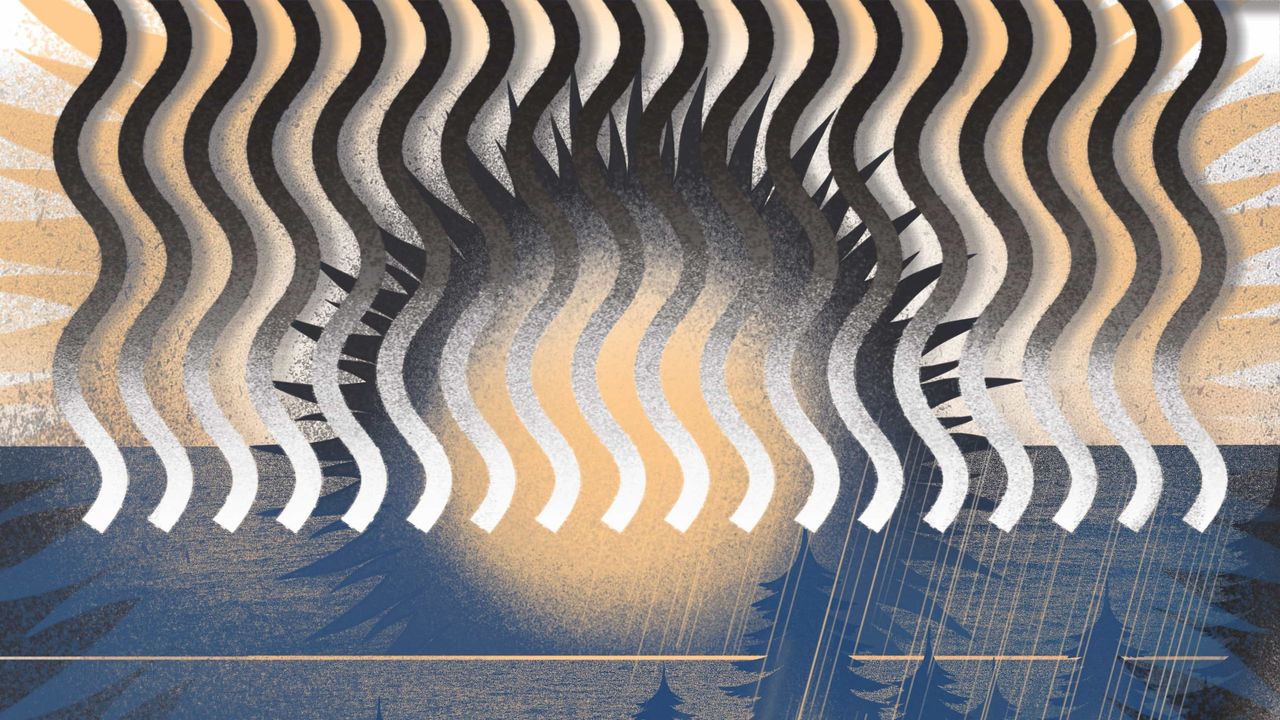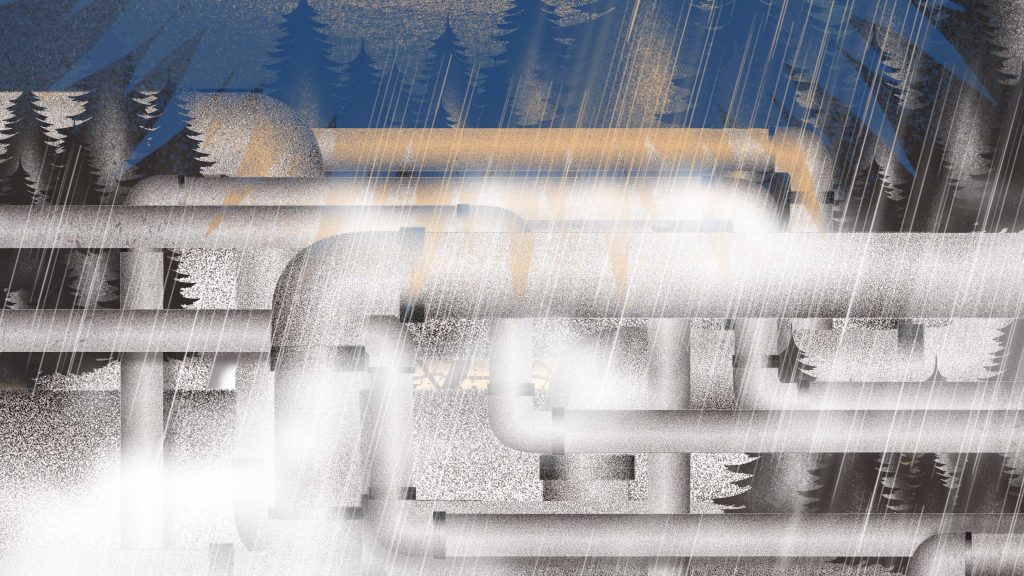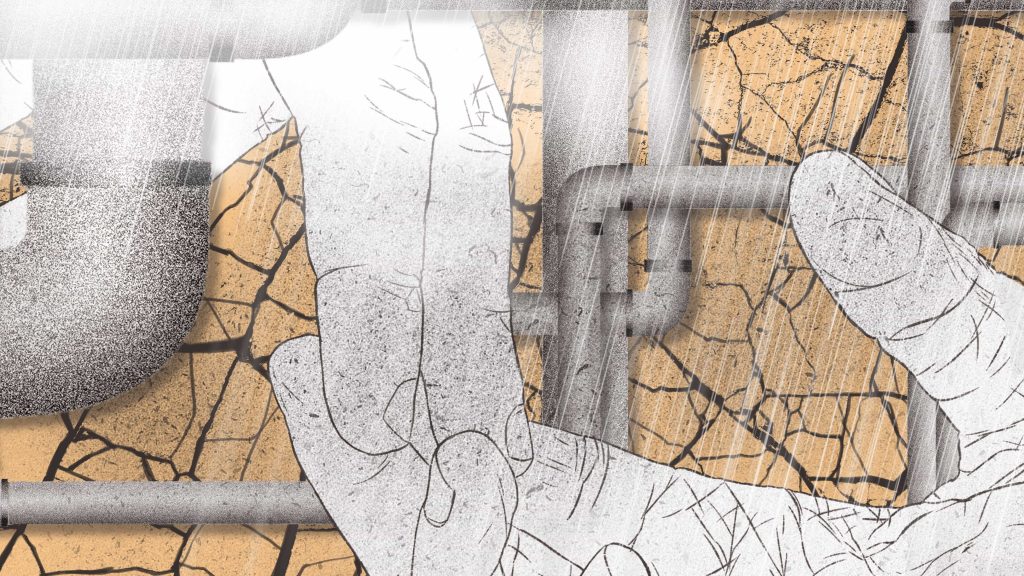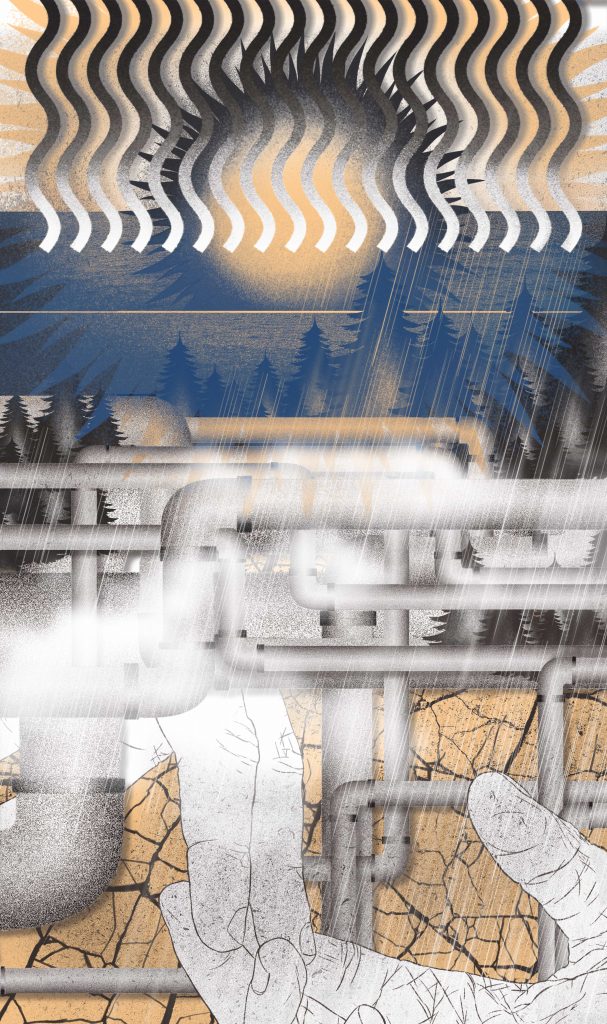
Drought is a phenomenon occurring naturally, and it is quite typical in our geographic location. Despite appearances, Poland is a country with limited water resources. Low-pressure zones coming from the Atlantic Ocean and bringing rain are mostly blocked over France and Germany and do not reach Poland, which more often faces dry high-pressure zones coming from Russia. Until the 1980s, droughts had hit our country every five years on average, but their frequency has increased – in recent years drought occurs every year. The desiccation of Poland is clearly visible when we look at the long-term analysis of the climate water balance, which is the indicator which takes into account the precipitation and evaporation of water. Since 1987, the balance sheet for the entire country has been positive or neutral only four times. In all the other years it was negative. The worst balance sheet was in 2018 and 2019.
Does Poland have a plan to combat the effects of drought? Well, it has two plans, actually. The first one is ministerial; the second is prepared by Krajowy Zarząd Gospodarki Wodnej [National Administration of Water Management]. Both methods are completely anachronistic and incompatible with current knowledge. Scientists suggest land restoration, deregulation of rivers, restoration of natural retention. In Poland, however, there are few examples of modern, conscious water management. Unfortunately they are not integrated with the local commune system, town system or even village system. On the other hand, the ideas that scientists, naturalists and conservationists talk about are successfully implemented in other parts of Europe, for example in Portugal, wherein during a dozen years or so the desert valley has been turned into a lively oasis.
***
Last winter there was little snowfall in Poland. Significant snowfall occurred only in the south of the country at the end of December 2019. Moreover, in Warsaw so far, there have been no days with temperatures below freezing. Instead, sometimes there was even 12 degrees Celsius. For many years the first snow has appeared later and later and there has been less and less of it. The last such snowless winter occurred in 1961 when the first snowfall in Warsaw happened only on January 8. This winter has a chance to be a special one in many ways.
Atmospheric drought is when there is no precipitation. Its consequence is agricultural drought, i.e. a situation when the amount of rainfall is less than the demand of arable crops for water. In the summer of 2019, the agricultural drought was announced in 14 voivodeships of the country, in 49% of communes. The prolonged lack of rainfall also causes hydrological drought – when water levels in rivers fall below the long-term average. In the long run, hydrological drought causes hydrogeological drought, i.e. long-term reduction of groundwater levels. The first three types of drought can disappear quite quickly due to heavy, continuous rainfall. However, rising groundwater levels is a long-term process.
***
Rainfall deficiency has been supplemented by water coming from melting snow. However, drought is not a phenomenon appearing only during the summer months. We are currently observing winter drought. It would seem that it is much less threatening. Unfortunately the vast majority of Polish rivers are rivers with a snow regime or snow and rain regime – the melting of snow conditions their flow. The lack of snow means a low level of rivers. Besides, relatively high winter temperatures mean the evaporation is increasing. At the end of January, all of the rivers or all of the major rivers have low or, at most, average water levels. In the absence of snow cover, the rivers drain groundwater resources, causing their levels to drop. At the end of December, the Polish Geological Institute – National Research Institute stated the threat of hydrogeological drought and possible difficulties in the water supply. In several voivodeships, soil moisture has already dropped to below 40% and agricultural and meteorological drought can be observed there. In 11 voivodeships, the level of groundwater fell below warning levels.
***

Dr Przemysław Nawrocki, a specialist in the protection of waters and species at the WWF Poland Foundation (WWF) explains the reasons standing behind this dramatic state of affairs.
– After the war, 80% of wetlands in Poland were drained, and they were turned into meadows, pastures and arable fields – explains Dr Nawrocki. – Moreover, normal drainage involves the construction of drainage ditches, equipped with valves closed during the drought period and opened during the period of the water excess. In Poland, 90% of ditches have no valves. The drainage systems are completely dysfunctional: ditches, even those unused ones, still drain the fields. As a result, the groundwater level in Poland fell by 1 metre. Over the years, we have consistently cut down forests, including those strategic ones. After the floods in 1997 and 2010, thousands of kilometres of small rivers were regulated – they were dredged and elutriated. As a result, we accelerated the flow of water, which drains the small catchment areas in the agricultural landscape and causes drought.
Lack of rainfall is not the only problem. Paradoxically, the problem is also downpours and flooding. Although the statistical rainfall remains at a similar level throughout the year, its characteristic is changing. Analyzes carried out for the project called Stop Drought! clearly show that the periods without rainfall in Poland will be longer and the number of days with continuous rainfall (those valuable for agriculture and groundwater) will decrease. Snowfall will also disappear, and the days with snow cover will shorten. Instead, there will be more frequent days with heavy rainfall. The trouble is that such precipitation cannot compensate for the effects of drought. Dried soil does not absorb a sudden amount of rainfall and water, instead of slowly soaking in and feeding the groundwater, flows straight into the rivers. When the rivers are regulated, a considerable amount of water quickly reaches the main rivers along which the cities are located. Shafts and reservoirs cannot withstand it, and we have a flood.
– That is the water management paradox – continues Dr Nawrocki – if you ask an average Pole about the cause of a flood, he will answer that the unregulated rivers are to blame. When you ask an average Pole about the cause of drought, he will answer that there are not enough retention reservoirs. It’s exactly the opposite. The increased risk of drought and floods is the result of our mindless environmental management. The problem is also a faulty law: anachronistic, contradictory and consistently treating water as a resource, and not as a common good of people and the environment. Financial goals are still more important than environmental ones.
It is clearly seen when we look at the government’s plans to combat the effects of drought. The authorities want to build more retention reservoirs and even navigable waterways on large Polish rivers, which will involve the construction of more than 30 reservoirs on the Oder and Vistula rivers.
– Both ideas are irrational and highly harmful – says Dr Nawrocki. – Retention reservoirs only make the problem worse. They damage the rivers, their biodiversity and cause substantial water losses due to evaporation. What’s more, they are simply recreational water reservoirs – local authorities build them under the guise of protection against flooding or drought prevention. In the light of knowledge, they have no rational justification. As for river transport – well, it was a good idea one hundred years ago, today it is an anachronism. Both approaches will absorb vast amounts of money that could be used wisely.
– So what should be done then?
– The essence of modern water management is slowing down the flow of water by restoring natural water landscape retention. It means putting an end to straightening the rivers, restoring wetlands, old river basins and ponds, retention of rainwater in the soil in agricultural areas, exactly where it falls, putting an end to the destruction of beaver ponds and taking care of strategic afforestation. Such actions will raise groundwater levels. You have to start cooperating with nature; you can not fight with nature.
****
– It was a desert when I came here 13 years ago. I have a photo: three large trees in the valley. Nothing more. We called this place a Desert Camp – says Bernd Mueller.
Tamera in southern Portugal. Extremely dry climate, temperatures in summer reach 40 degrees Celsius. The area was once covered with forests, but trees were cut for arable fields. The last ones were cut down in the 1960s. Lack of forests and monoculture plants caused rapid soil erosion, and the area became agriculturally useless. The Alentejo Region has been struggling with constant drought and progressing desertification for years. Periods of extremely high temperatures are getting longer, periodic rains – more and more violent. In some municipalities, authorities encourage people to move to more arable areas. In the 1990s, only two families lived in the valley in Tamera.
In 1995, 150 ha in the valley in Tamera was bought by Dieter Duhm and Sabine Lichtenfels. They founded the experimental Peace Research and Education Center. Their dream was to create a self-sufficient, sustainable, replicable model of a community based on peaceful cooperation and harmonic coexistence between people, animals and nature. Today, around 300 inhabitants permanently live in Tamera. In summer, when the community receives guests, about 500 of them come there.
– We have faced the same problem every year: will everyone have water, food and energy – says Mueller. – We did not want to be constantly dependent on products delivered from remote cities. The community had to become self-sufficient. The key was water.
Mueller studied civil engineering in Germany, but he did not graduate. Then he started studying landscape design, moved to Spain and ran a farm for 20 years.
– When I was studying, I asked one of the professors what the water is. And I got a stupid theoretical l answer. I was looking for someone at the university who could tell me about water in a different, not technical way. I have not found someone like that. And then I read the scientific work of Viktor Schauberger, an Austrian scientist and naturalist who lived in the first half of the 20th century. Schauberger already saw the danger of climate change. He claimed that people had to learn how to use water properly once again. Then everyone will have free access to basic needs: water, food and energy. It is an extremely bold statement if you look at the condition of today’s world.
Mueller shows me the drawings of the water cycle in nature, which is known to everyone who was attending high school. The first one shows a natural, unharmed ecosystem. In essence, water evaporates from the oceans, migrates above the land, falls as rain, soaks into the soil, supplies underground water and by penetrating through the soil comes back to the oceans.
– The trouble is that we destroyed that natural cycle – explains Mueller. – When you remove forests from our example illustration, water flows down the earth’s surface instead of infiltrating groundwater. When you add farmland, huge cities and hardened areas in place of forests, you will see that not only the water cycle changes but also the air circulation, because the moist air from the sea does not enter so easily the space above the warmed lands. However, this process can be reversed.
Mueller invited Sepp Holzer, an international specialist in natural agriculture, to cooperate in Tamera. Holzer, nicknamed “Rebel Farmer”, has an unconventional, radical approach to nature. Together they created the concept of landscape retention covering the entire valley. The main assumption was to restore the hydrological balance in the valley and retain all the rainwater so that it could feed the groundwater.
– We started by estimating how much water we have in the valley – says Mueller. – Well, we know the surface of our area and the water catchment area. We also know the soil condition and statistical rainfall – about 700 mm per year. The calculations prove that we are losing unbelievable amounts of water.
How much water? Mueller and Holzer experimented. The result was converted into tanks containing one cubic metre of water. They were amazed by the result: if the containers were placed next to each other, they would form a chain 1000 km long. It’s like a distance between Tamera and Barcelona.
– I show the results of the experiment to everyone who visits Tamera. When you realise that, the question if we have enough water to drink becomes completely absurd – laughs Mueller.

***
Water retention landscape in Tamera is a decentralised system of simple buildings that slow down the flow of water throughout the entire water catchment area. Ponds, backwater valves, ditches, drainages, small dams, terrace cultivation – technologies known from ancient times – and designed according to the knowledge of water and nature. The first was a pond in 2007. It became full of water after only two years.
– We started to move the water as Schauberger advised – Mueller says. – The change was incredibly touching. Only a few months after the end of work, a small river started flowing through our area. It has never dried so far.
By 2015, 29 small ponds and retention reservoirs with a total area of 8.32 ha were built in the valley. They differ fundamentally from traditional retention reservoirs – they are not built on the river. They collect rainwater that flows down the ground. All installations are made of natural, local materials – sand, clay, stones – without the use of concrete or foil. The ponds are in natural shape resulting from the terrain and, if possible, are located along the valley according to the direction of the prevailing winds.
It makes water – steadily moved by the wind – cleaner and better aerated. Ponds also have natural zones of deeper and shallower water; their banks meander freely and are never hardened. The tanks are surrounded by natural greenery, providing shade. The largest ponds are located on the highest levels in the valley so that water pressure irrigates the area without the help of irrigation systems and pumps. Ponds maintain a stable water level throughout the year. An essential function of ponds is to create a microclimate. Water evaporates, creating moisture, moisture makes the climate milder in both winter and summer. A local, small water cycle is created that allows vegetation to grow. But the ponds are not the only element of the system. Special ditches running in line with the contour lines across the slopes were also used in the valley. It means that during heavy rains ditches stop the water flow and prevent further soil erosion. Screens protecting against the wind are also used in many places because they protect the ground surface from the wind, so the evaporation is slower. Natural soil protection, i.e. plant litter has also been restored. A layer of leaves and straw protects the soil from excessive sunlight, reduces evaporation and supports the formation of humus. The vegetation in the valley has been arranged by the demand for water and optimal insolation for a given species. Working together, these simple solutions ensure that all rainwater remains in the valley.
– The biggest challenge was convincing our neighbours to the whole idea. They were sure that the retention system in our area would deprive their farms of water and our actions would interfere with the natural ecosystem – Mueller says. Another obstacle in the implementation of the project was the local law. The investment in Tamera was mostly an unauthorised construction. Preparation of all the necessary documents, expertise and permits related to the construction of retention ponds would take so long that the landowners decided to start the investment without them and legalise everything after construction.
The effects of the project convinced the local authorities to support it. After 13 years, Tamera is no longer a desert. The valley is covered with natural vegetation, including trees, there are several hectares of fruit and olive orchards and gardens. Fish live in streams and reservoirs, and wild animals returned to the valley. Tamera is not only self-sufficient in terms of water – but it also generates water for neighbours throughout the year.
– I don’t doubt: what we have done can be applied in other parts of Europe – says Mueller. – By restoring the natural circulation of water on a global scale, we can not only prevent the effects of drought but also reverse climate change to some extent. We won’t do that by merely trying to reduce carbon dioxide emissions. The natural water cycle gives a chance to rebuild vegetation on a vast scale, and this is a critical factor in the carbon dioxide emission cycle.
***
The implementation of the project cost half a million euro. Is it a lot? It depends on the perspective. It’s a lot of money for a private investor, as was the case with the Tamera project. Mueller and Holzer financed their project from public collections. Considering only a bill of costs and profits for agriculture, the investment has no chance to pay back, which may be an argument against the implementation of such projects. However, when we add the value of the so-called ecosystem services, which is already possible – taking under consideration the long-term benefits for the environment and the improvement of the quality of life of the local community – half of million euro does not seem to be a large amount of money—especially taking into account the city, province or state budget.
Polish law imposes on the Państwowe Gospodarstwo Wodne Wody Polskie [Polish Waters – the leading water management institution in Poland] the obligation to maintain watercourses in the so-called good technical condition and ensuring the free flow of water and ice. Although it may sound reasonable to the uninformed public, the reality is different. According to the law, Polish Waters must spend lots of money every year on deepening riverbeds and streams, removing fallen trees, strengthening water-washed slopes, cutting down trees and shrubs growing on the banks. All these activities can make sense in case of rivers flowing through densely built-up areas. However, in the case of rivers and streams running through the field and forest landscape, it most often does not make sense. So millions of zlotys are and will continue to be spent on activities that accelerate the flow of water and aggravate the problem of drought. The money can be spent on landscape retention projects. Moreover – effective landscape retention can be much simpler than the one in Tamera, where the groundworks related to the construction of numerous ponds, which are not an indispensable element of the system, generated high costs and formal difficulties.
– Tamera’s example shows that it is worth reconstructing landscape water retention in the landscape, cooperating with nature and repairing the disturbed links between precipitation water, surface water and groundwater – Przemysław Nawrocki from WWF comments. – It is the approach we need in Poland. We need to implement it on a large scale, on the scale of entire river basins. Only then would there be a guarantee that public funds allocated to river management and drought prevention will be well used.
The law also requires some changes, which makes it very difficult to introduce such solutions. An additional problem, typical for Poland is the extensive land fragmentation, especially in the south and east of the country, which hampers such significant investments. We have some examples of restoring natural retention, but in our society, among politicians and people who manage water resources, a modern approach to water resources based on the renaturalization of water ecosystems is still unpopular. Much remains to be done in the case of education and broad cooperation between citizens and the state in caring for the quantity and quality of water. After all, it is the source of life not only for us but also for nature.
– We need to start thinking about water more holistically. Do you know what the influence of scientists and their research results on politicians’ decisions is? – Nawrocki asks at the end of our conversation.
– No, I don’t.
– Just 1% – he underlines.

Landscape retention projects based on the Tamera model are implemented in Spain. Tamera is also a model example for the European Environment Agency (EEA) in terms of rainwater retention and is shown as an example at conferences about climate. The Tamera model is also taught at the University of Lisbon.
– We are discussing Tamera as an inspiring example of adaptation to climate change. All actions aimed at restoring good quality soil, preventing erosion and raising the level of groundwater are invaluable and should be implemented throughout the Iberian Peninsula. Healthy soil and water reservoirs mean higher humidity, and thus the ability to reforestation, that the peninsula lacks so much. It would help to restore the natural water cycle and bring the moisture from the ocean – says Professor Gil Peña-López, who works at the Faculty of Science, Center for Ecology, Evolution and Environmental Change at the University of Lisbon.
– Is it possible that solutions from Tamera can be scaled and used in other places?
– Well, that’s the dream of the creators of Tamera model and the subject of my research. There is an idea to create a system of thousands of small water reservoirs throughout Alentejo province that will allow precipitation to permeate to the groundwater. However, the methods must be tailored to local conditions, drought type, climate and the nature of rainfall. For example – the solutions applied in Tamera are not optimal for the development of agriculture, but it was not the primary goal. However, the costs remain the biggest obstacle in achieving the given objectives. Another issue is that adaptation to climate change depends on the progress of those changes. If their impact is powerful, it may turn out that some solutions cease to make sense. Therefore there is a severe dilemma – in which solutions to invest. Nevertheless, the restoration of soil and natural landscape retention in Alentejo is extremely important – in the worst case scenario, it may turn out that the region turns into a desert – explains professor Gil Peña-López.
For a year Bernd Mueller has been a consultant for local authorities who want to apply similar solutions for the entire municipality of Odemira, the largest one in Portugal.
– It is necessary to change the way we think, from exploitation to cooperation – explains Mueller. – I call it the new paradigm of water. If you focus on collaboration, then you need to get to know your partner well. At present, we treat nature as something external; we do not consider ourselves a part of nature. It allows us to rob, dominate and control the natural environment. But we already know that in this way we won’t get too far. If we want to build a world without water conflicts, we need social solutions and communication between people. We also need communication between people and other living beings. When we realize that nature is a living being and we are part of it, everything will change. We are talking about our own lives.
—
Artykuł został przygotowany w ramach konkursu #MamyWspólneCele edycja 2019 r. Partnerem konkursu był Santander Bank Polska S.A.























